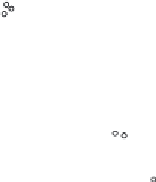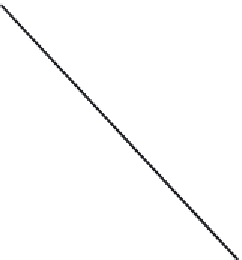Geoscience Reference
In-Depth Information
ure 2a). The ratio of the mean horizontal stress to the vertical stress (Figure 2b) appears to vary over a narrower
range with increasing depth, the ratio being generally less than 1 at depths larger than 2 km (~1.2 miles).
The relative magnitude of the three principal stresses,
σ
h
,
σ
H
, and
σ
v
, establishes the conditions for the
orientation of the faults. Three regimes of stress, each associated with different fault orientations, are commonly
defined (Figure 3): (a) thrust fault regime with
σ
v
equal to the minimum principal stress, (b) normal fault regime
continued
(a)
(b)
0
0
1
1
2
2
3
3
0
1
2
3
4
0
20
40
60
80
100
Vertical stress (MPa)
Figure 2
(a) Vertical stress variation with depth; the linear trend corresponds to a mean density of 2,700 kg/m
3
.
(b) Variation of the ratio of the mean horizontal stress (
σ
H
+
σ
h
)
/2
over the vertical stress
σ
v
with depth.
SOURCES: Figure modified from Jaeger et al.
(2007), which was itself redrawn from the original figure of
Brown and Hoek (1978).
(a)
(b)
(c)
Strike-slip fault
Thrust fault
Normal fault
Figure 3
(a) Thrust fault, (b) normal fault, and (c) strike-slip fault. (Cross sections shown are in vertical plane
for (a) and (b) and horizontal plane for (c).)











































































































































































































































































Search WWH ::

Custom Search